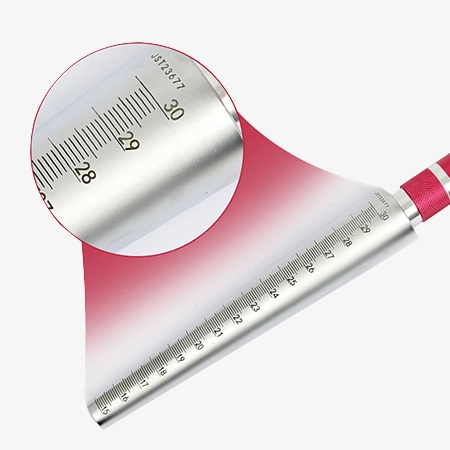SISCO conical feeler gauge is made of durable and long-lasting stainless steel for reliable performance, features a precise structure with an accuracy of 0.1mm, ensuring quick and accurate measurements. The feeler gauge is suitable for measuring thin-walled parts, plastic tubes, inner diameters, bores, and more, making it a versatile tool for different applications.

Knurled pattern design to prevent falling off
- The feeler gauge handle features a knurled texture, providing a secure grip to prevent slipping, even in oily or wet conditions, enhancing control and ease of use.
- The knurled pattern offers a more stable grip, allowing precise handling, especially for fine measurements where accuracy is crucial.
- The knurled surface not only improves grip but also reduces hand fatigue during extended use, making it comfortable and practical for various applications.

Laser engraving, clear and wear-resistant
- The SISCO conical feeler gauge features precision laser-etched markings that are clear and easy to read, ensuring accuracy and convenience during measurements.
- The markings are highly resistant to wear and fading, maintaining clarity even after extensive use, which supports long-term accuracy.
- The durable, high-contrast laser etching provides excellent readability in various lighting conditions, making it practical for both indoor and outdoor use.
Dimension

Applications
SISCO feeler gauge is a precision tool designed to measure the clearance or gap between two surfaces. It’s widely used in automotive repair to check valve and spark plug gaps, in machinery calibration for precise tolerance settings, and in electronics assembly to ensure proper spacing between components, and in industrial equipment maintenance to verify part alignment and prevent excessive wear.

Machinery Calibration

Electronics Assembly

Equipment Maintenance

Automotive Repair
| Model | SISCO-FG-YZ315 | SISCO-FG-YZ1530 |
| Measuring Range | 3-15mm | 15-30mm |
| Blade Length | 133mm | 167mm |
| Graduation Value | 0.1mm | |
| Taper | 1:10 | |
| Accuracy | ±0.05 | |
| Ruler Structure | Solid | |
| Material | 45# Steel | |
| Weight | 110g | |
Q1: What is a feeler gauge?
A1: A feeler gauge is a precision tool used to measure the gap or clearance between two surfaces. It consists of a set of thin, flat blades of various thicknesses, each marked with its corresponding measurement. These blades can be inserted into the gap to determine its size. Feeler gauges are commonly used in mechanical, automotive, and industrial applications to check the spacing between parts such as engine valves, spark plugs, or machinery components, ensuring they meet specific tolerance requirements.
Q2: Can I use multiple blades at once?
A2: Yes, you can use multiple blades from a feeler gauge set at once. This is often done when the gap you need to measure falls between the thicknesses of two or more individual blades. By stacking multiple blades together, you can achieve the desired thickness and accurately measure the gap.
For example, if the gap is 0.25 mm and there is no single blade that matches this exactly, you could use a 0.15 mm blade and a 0.10 mm blade together to measure the gap. Just make sure the stacked blades fit snugly and fully into the gap for an accurate measurement.
Q3: Can feeler gauges be used for all types of measurements?
A3: Feeler gauges are specifically designed for measuring narrow gaps or clearances between two surfaces, so they are not suitable for all types of measurements. They are ideal for tasks such as checking the clearance in engine parts, machinery, or measuring small gaps in assemblies. However, feeler gauges are not suitable for measuring large gaps, thicknesses of solid materials, or external dimensions like the diameter of a cylinder.
For measurements outside their intended purpose, such as material thickness or larger distances, other tools like calipers, micrometers, or thickness gauges are more appropriate and accurate.
Tips: What is a conical feeler gauge used for?
A conical feeler gauge is used for measuring small gaps or clearances, particularly in tight, angled, or irregular spaces where a standard flat feeler gauge may not fit. Its tapered (cone-shaped) blades allow for precise measurements in areas with varying gap sizes, making it ideal for applications where precision is crucial. Common uses include:
- Automotive work: Measuring gaps in engine components like valves, pistons, or spark plugs.
- Mechanical applications: Checking tolerances in machinery, gears, and bearings.
- Precision engineering: Used to check and adjust gaps in various mechanical assemblies, ensuring optimal performance and preventing wear.
The conical design allows for better access to hard-to-reach spaces, making it valuable for more specialized measurements.
Thank you for buying industrial test and measurement equipment on SISCO.com, all products sold by SISCO and the partner cover a 12 months warranty, effective from the date of receiving the products.
What is covered?
SISCO is responsible for providing free spare parts, and free technical support to assist the customer to repair the defective products until the problem is solved.
What is not covered?
- Product purchased from anyone other than a SISCO store or a SISCO authorized reseller.
- Expendable parts.
- Routine cleaning or normal cosmetic and mechanical wear.
- Damage from misuse, abuse or neglect.
- Damage from use of parts other than SISCO approved.
- Damage from use outside the product’s usage or storage parameters.
- Damage from use of parts not sold by SISCO.
- Damage from modification or incorporation into other products.
- Damage from repair or replacement of warranted parts by a service provider other than a SISCO authorized service provider.
- Damage caused by the application environment not meeting the product usage requirements and the failure to perform preventive maintenance.

